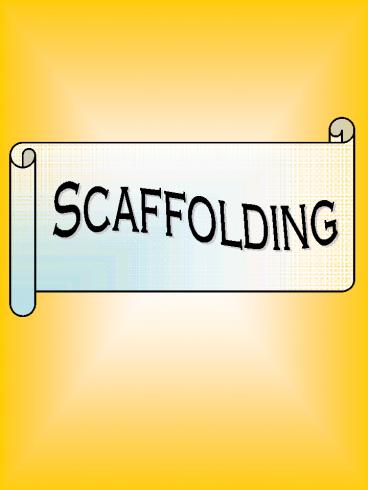Scaffolding PowerPoint PPT Presentation
Title: Scaffolding
1
Scaffolding
2
- The term scaffolding comes from the works of
Wood, Bruner and Ross (1976). The metaphor
describes the type of assistance offered by a
teacher or peer to support learning. - Scaffolding is an interactive method of teaching
and learning where the teacher provides a
temporary framework for the learner who is
working just beyond independent capabilities
(NTDE 1995). It can and should occur in all
aspects of learning in order to assist students
to achieve their potential, comprising guiding,
modelling and cueing of students. This is
achieved by the teacher sharing the cognitive
workload to link the known to the unknown using
techniques of - Cueing and questioning
- Demonstrating and modelling
- Role and problem identification
- Planning
- Monitoring
- Evaluation
3
- Language teaching in Australia has been heavily
influence by the work of Prof. Michael Halliday
who developed systemic functional grammar. His
work has also been taken up and further developed
by linguists such as Jim Martin and others. - Functional grammar relates grammar to meaning,
and to the contexts in which language occurs. It
takes into account factors which relate to the
context in which the language is being used and
the social purpose. - What is being talked about? FIELD
- Who are the participants and what is the
relationship - between them? TENOR
- What is the mode of the discourse? MODE
- What is the social purpose of the language? GENRE
4
- Stage 1 Building The Field Students become
familiar with the subject matter, or field of
what they will write about. - Stage 2. Modelling/Deconstruction Students
look at other examples of the same writing
genre. At this stage, the teacher and students
discuss the purpose of the writing, how it is
structured, and relevant grammatical features. - Stage 3 Joint Construction Joint construction,
when students, altogether as a whole class, do
a similar piece of writing with the help of the
teacher. The students give ideas, the teacher
writes what they say on the board. Together
they talk about expression, grammar,
vocabulary and so on. - Stage 4 Independent Construction Students
individually do their own writing using what
they have learnt in the previous stages.
5
By using this approach, students learn to
listen, speak, read and write English, in the
context of learning about a curriculum topic.
They are also developing research skills and
learning how to structure the different genres
or types of texts, and the grammar which is
associated with them. They are also learning how
to talk about language, but in the context of
actually using it. They are also learning
subject content. See example.
6
Practical ways to increase responsibility for
their learning.
- Frameworks
- Concrete examples
- Building on what students say
- Rephrasing
- Guided questioning
- Charts
- Picture cues
- Word lists
- Negotiation of texts before writing independently
- Body language and gesture
- Work from oral to written
- By using the above techniques teachers can
structure the teaching/learning situations so
that the students can be successful.
- For the ESL learner scaffolding is essential if
he/she is to feel comfortable to take risks using
English at school. Through scaffolding, the
teacher is able to set the learner up to succeed
in set tasks, when this happens, learning becomes
intrinsically motivating

